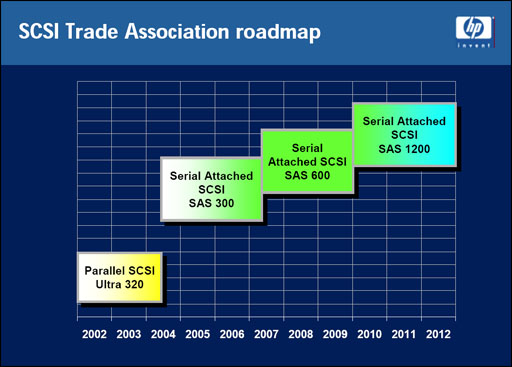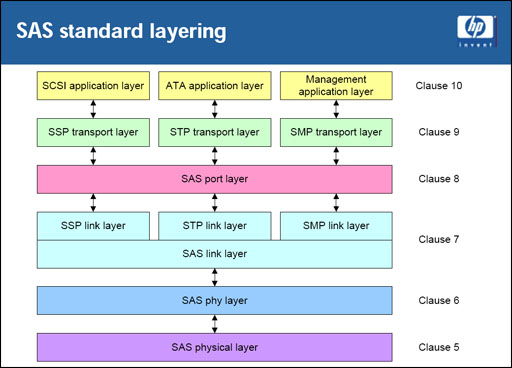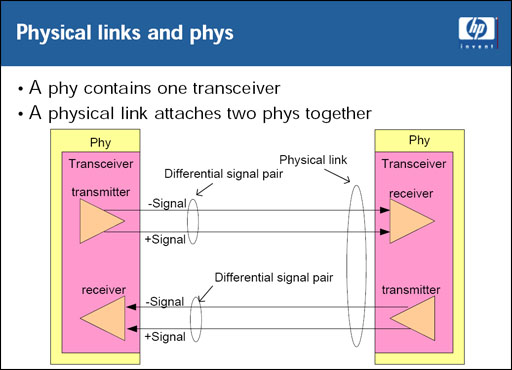Promise VTrak J300s
by Jason Clark & Dave Muysson on February 2, 2007 8:00 AM EST- Posted in
- IT Computing
Basic SAS Architecture
The main advantages for SAS over SCSI are that it has a point to point architecture and much smaller cabling requirements. Modern parallel SCSI operates on a shared bus (every device shared the total bus bandwidth and was limited by the slowest device), ranging in bandwidth from 160MB/s to 320MB/s. SAS is capable of 3Gbit with 6Gbit in the works, and with the 8/10 data encoding that works out to 300MB/s and 600MB/s. More importantly, that bandwidth is per device, so it is unlikely in the near term that any single device will be able to saturate the available bandwidth. One other huge advantage that SAS has is its ability to interoperate with SATA devices. Most of the SAS enclosures sold today offer the ability to mix SAS and SATA drives, which allows for endless possibilities in architecting a storage infrastructure. Below is the SAS roadmap from the SCSI Trade Association.

As you can see from the diagram below, the SAS standard layering is made up of 6 distinct layers, each with a specific purpose.

The lowest layer of SAS is the physical link layer, which consists of cables, connections, and the electrical characteristics for the SAS transmitter and receiver in the SAS phy. A SAS phy is a combination of the physical layer, phy layer and the link layer functions. A phy at the target and the initiator make up a physical connection. When multiple phy's are grouped together, it can be referred to as a "Wide Port". Once each pair of phys is connected together to form a physical link, the aggregate bandwidth of the port will incrementally increase.

The link layer is the third lowest layer and it interfaces with the SAS phy layer and the SAS Port layer. Its main purpose is to control the SAS phy layer to manage connections with other SAS devices. Next in the stack is the Port layer; it receives requests from the transport layer, interprets the requests, selects link layers (which in turn select phys that are used to establish connections), and forwards the requests to the selected link layer for transmission.
The second highest layer is the transport layer. This layer receives requests from the application layer, constructs frames and sends them to the port layer, validates the frames and notifies the application layer. Last but certainly not least is the application layer, whose main purpose is to create tasks for the transport layer to process.
The main advantages for SAS over SCSI are that it has a point to point architecture and much smaller cabling requirements. Modern parallel SCSI operates on a shared bus (every device shared the total bus bandwidth and was limited by the slowest device), ranging in bandwidth from 160MB/s to 320MB/s. SAS is capable of 3Gbit with 6Gbit in the works, and with the 8/10 data encoding that works out to 300MB/s and 600MB/s. More importantly, that bandwidth is per device, so it is unlikely in the near term that any single device will be able to saturate the available bandwidth. One other huge advantage that SAS has is its ability to interoperate with SATA devices. Most of the SAS enclosures sold today offer the ability to mix SAS and SATA drives, which allows for endless possibilities in architecting a storage infrastructure. Below is the SAS roadmap from the SCSI Trade Association.

As you can see from the diagram below, the SAS standard layering is made up of 6 distinct layers, each with a specific purpose.

The lowest layer of SAS is the physical link layer, which consists of cables, connections, and the electrical characteristics for the SAS transmitter and receiver in the SAS phy. A SAS phy is a combination of the physical layer, phy layer and the link layer functions. A phy at the target and the initiator make up a physical connection. When multiple phy's are grouped together, it can be referred to as a "Wide Port". Once each pair of phys is connected together to form a physical link, the aggregate bandwidth of the port will incrementally increase.

The link layer is the third lowest layer and it interfaces with the SAS phy layer and the SAS Port layer. Its main purpose is to control the SAS phy layer to manage connections with other SAS devices. Next in the stack is the Port layer; it receives requests from the transport layer, interprets the requests, selects link layers (which in turn select phys that are used to establish connections), and forwards the requests to the selected link layer for transmission.
The second highest layer is the transport layer. This layer receives requests from the application layer, constructs frames and sends them to the port layer, validates the frames and notifies the application layer. Last but certainly not least is the application layer, whose main purpose is to create tasks for the transport layer to process.










31 Comments
View All Comments
JarredWalton - Monday, February 5, 2007 - link
"or seek times" = "where seek times"yyrkoon - Saturday, February 3, 2007 - link
many 'old timers' are going to claim SCSI is better than anything, because its been around a long time, and has a proven track record. What these 'old timers' don't realize, is that SAS, and SCSI drives, share the same ancestry, except that SAS, also shares a history with SATA. *shrug*mino - Sunday, February 4, 2007 - link
Yes they are those.However most posters here do NOT dispute the benefits and superiority os SAS over U320.
The point is that according the numbers published even SATA 7.2k is on par with SCSI320 10k !!!
Those numbers simply coudn't be much more away from the reality then they are.
Artificially more than halving the performance of a tested platform simply is not acceptable.
Also to make tables in the sense SATAI vs. SATAII vs. SCSI vs. SAS is on itself seriously misleading to the extent that best thing to do for AT (provided they were not paid for it!) would be to call in the article eithe indefinitelly or for rewrite.
Actually the reality is:
SATA I or SATA II driver do not exist, there are only SATA drives inn existence as of now.
performance-wise on single to 6-drives/system:
SATA(7.2k) < SATA(10k) < SCSI(10k) = SAS(10k) < SCSI(15k) = SAS(15k)
on 8+drives system:
SATA(7.2k) < SATA(10k) < SCSI(10k) < SAS(10k) < SCSI(15k) < SAS(15k)
For an 12-drive test the results should be:
SATA(7k) << SCSI(10k) << SAS(15k) which is obvious even before any testing.
However much more beneficial test would be:
SATA(10k-Raptor) vs. SCSI(10k) vs. SAS (10k) with SCSI and SAS driver ideally from the same line.
mino - Sunday, February 4, 2007 - link
"SATA I or SATA II driver" --> "SATA I or SATA II drives"mino - Saturday, February 3, 2007 - link
Yes, one sometimes has to make compromises.But benchmarking SCSI setup with 12drives on a SINGLE cable is plain stupid and tabloid-like aproach.
This organization seriously criples perfromance and is NEVER used unless there is some very serious reason for it.
mino - Saturday, February 3, 2007 - link
If you did have no SCSI option than the one you used, you should not have published those "SCSI" numbers at all. Those numbers as they are have nothing to do with SCSI being poor, they are simply showcasing that 3yrs 10k drive are slower than new 15k drives. Nothing new here.Googer - Friday, February 2, 2007 - link
That chart is missing the old 5.25 inch drives. The most famous of those was probably the Quantum Bigfoot. Quantum was bought out by Maxtor.http://images.anandtech.com/reviews/it/2007/promis...">http://images.anandtech.com/reviews/it/.../promise...
http://www.pcguide.com/ref/hdd/op/formIn525-c.html">http://www.pcguide.com/ref/hdd/op/formIn525-c.html
Justin Case - Friday, February 2, 2007 - link
Maybe the article author should read this...http://www.sata-io.org/namingguidelines.asp">http://www.sata-io.org/namingguidelines.asp
monsoon - Friday, February 2, 2007 - link
Hello,I'm used to change computers frequently, I have lots of data to store.
Currently I've got 4 external 300Gb drives and 4 external 400Gb drive; all of them connected through firewire.
I've been looking eagerly for solutions similar to the NORCO DS-1220; but I need to connect the storage unit to laptops as well, so it has to control RAID5 all by itself.
I can't find alternatives in the market, and while the UNRAID solution looks interesting, it's not safe, neither easy to implement.
Looking forward to external storage devices reviews for home users with big archives.
Units need to stand the test of time and be there while PCs come and go.
Ideally, I must be able to replace drives with higher capacity when they get cheaper, without having to replace all of them at the same time.
It better be silent; well, at least not loud...
Any idea ?
Thanks
mino - Saturday, February 3, 2007 - link
Look for some reliable NAS solution (+Gbit swith - now dirt cheap).